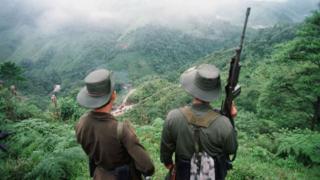Disir
Platinum Member
- Sep 30, 2011
- 28,003
- 9,608
- 910
Tanja Nijmeijer of Holland spent more than 10 years fighting with the rebel group FARC in the jungles of Colombia. More recently, she has been part of the guerillas' peace negotiating team in Cuba. What drives her?
Until recently, there had long been only two possible fates awaiting Tanja Nijmeijer: a grave in the Colombian jungle or a cell in an American maximum-security prison. Nijmeijer has never had any doubts as to which option she would prefer. "I will die in the jungle," she says.
Nijmeijer is wanted by Interpol for three cases of kidnapping, the use of a firearm during a violent crime and supporting a terrorist organization.
Read the rest here:
A Meeting with Dutch FARC Member Tanja Nijmeijer - SPIEGEL ONLINE
This is a very interesting two part-er. Fifty years is entirely too long and I doubt that peace is coming. The automatic responses to questions on FARC at the end are exceptionally rattling.



